Francesc Wilhelmi
Performance Analysis of IEEE 802.11bn Non-Primary Channel Access
Apr 22, 2025Abstract:This paper presents a performance analysis of the Non-Primary Channel Access (NPCA) mechanism, a new feature introduced in IEEE 802.11bn to enhance spectrum utilization in Wi-Fi networks. NPCA enables devices to contend for and transmit on the secondary channel when the primary channel is occupied by transmissions from an Overlapping Basic Service Set (OBSS). We develop a Continuous-Time Markov Chain (CTMC) model that captures the interactions among OBSSs in dense WLAN environments when NPCA is enabled, incorporating new NPCA-specific states and transitions. In addition to the analytical insights offered by the model, we conduct numerical evaluations and simulations to quantify NPCA's impact on throughput and channel access delay across various scenarios. Our results show that NPCA can significantly improve throughput and reduce access delays in favorable conditions for BSSs that support the mechanism. Moreover, NPCA helps mitigate the OBSS performance anomaly, where low-rate OBSS transmissions degrade network performance for all nearby devices. However, we also observe trade-offs: NPCA may increase contention on secondary channels, potentially reducing transmission opportunities for BSSs operating there.
Federated Learning in Mobile Networks: A Comprehensive Case Study on Traffic Forecasting
Dec 05, 2024



Abstract:The increasing demand for efficient resource allocation in mobile networks has catalyzed the exploration of innovative solutions that could enhance the task of real-time cellular traffic prediction. Under these circumstances, federated learning (FL) stands out as a distributed and privacy-preserving solution to foster collaboration among different sites, thus enabling responsive near-the-edge solutions. In this paper, we comprehensively study the potential benefits of FL in telecommunications through a case study on federated traffic forecasting using real-world data from base stations (BSs) in Barcelona (Spain). Our study encompasses relevant aspects within the federated experience, including model aggregation techniques, outlier management, the impact of individual clients, personalized learning, and the integration of exogenous sources of data. The performed evaluation is based on both prediction accuracy and sustainability, thus showcasing the environmental impact of employed FL algorithms in various settings. The findings from our study highlight FL as a promising and robust solution for mobile traffic prediction, emphasizing its twin merits as a privacy-conscious and environmentally sustainable approach, while also demonstrating its capability to overcome data heterogeneity and ensure high-quality predictions, marking a significant stride towards its integration in mobile traffic management systems.
Coordinated Multi-Armed Bandits for Improved Spatial Reuse in Wi-Fi
Dec 04, 2024



Abstract:Multi-Access Point Coordination (MAPC) and Artificial Intelligence and Machine Learning (AI/ML) are expected to be key features in future Wi-Fi, such as the forthcoming IEEE 802.11bn (Wi-Fi 8) and beyond. In this paper, we explore a coordinated solution based on online learning to drive the optimization of Spatial Reuse (SR), a method that allows multiple devices to perform simultaneous transmissions by controlling interference through Packet Detect (PD) adjustment and transmit power control. In particular, we focus on a Multi-Agent Multi-Armed Bandit (MA-MAB) setting, where multiple decision-making agents concurrently configure SR parameters from coexisting networks by leveraging the MAPC framework, and study various algorithms and reward-sharing mechanisms. We evaluate different MA-MAB implementations using Komondor, a well-adopted Wi-Fi simulator, and demonstrate that AI-native SR enabled by coordinated MABs can improve the network performance over current Wi-Fi operation: mean throughput increases by 15%, fairness is improved by increasing the minimum throughput across the network by 210%, while the maximum access delay is kept below 3 ms.
Machine Learning & Wi-Fi: Unveiling the Path Towards AI/ML-Native IEEE 802.11 Networks
May 19, 2024



Abstract:Artificial intelligence (AI) and machine learning (ML) are nowadays mature technologies considered essential for driving the evolution of future communications systems. Simultaneously, Wi-Fi technology has constantly evolved over the past three decades and incorporated new features generation after generation, thus gaining in complexity. As such, researchers have observed that AI/ML functionalities may be required to address the upcoming Wi-Fi challenges that will be otherwise difficult to solve with traditional approaches. This paper discusses the role of AI/ML in current and future Wi-Fi networks and depicts the ways forward. A roadmap towards AI/ML-native Wi-Fi, key challenges, standardization efforts, and major enablers are also discussed. An exemplary use case is provided to showcase the potential of AI/ML in Wi-Fi at different adoption stages.
Continuous Multi-Link Operation: A Contention-Free Mechanism for the Unlicensed Spectrum
May 15, 2024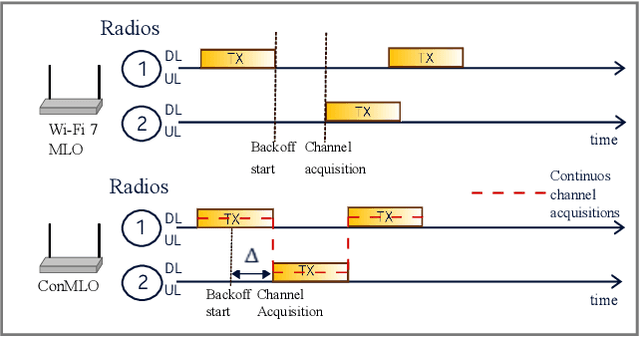
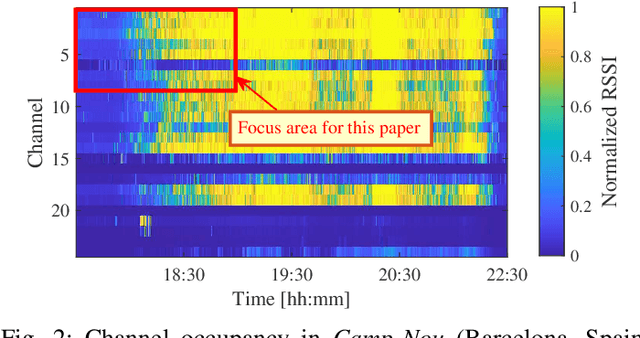
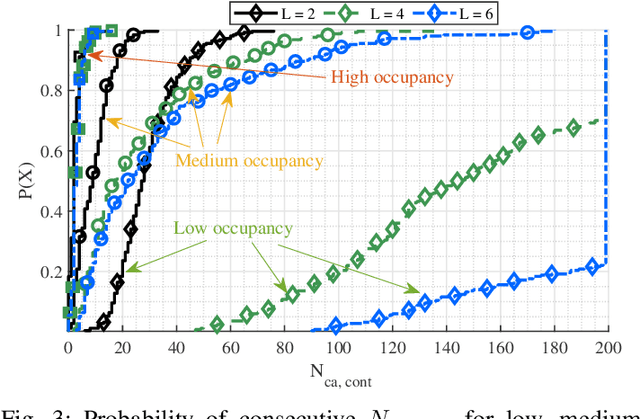
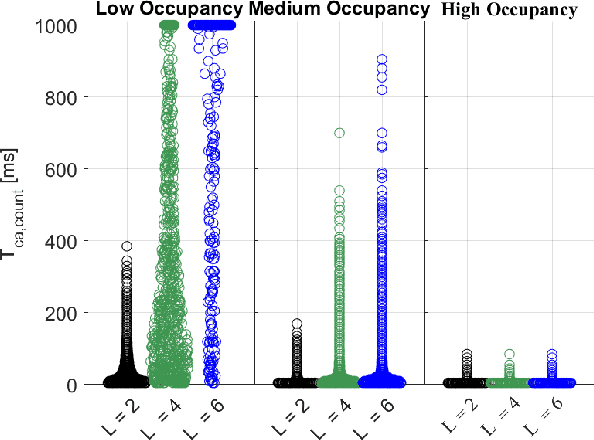
Abstract:This paper proposes a novel mechanism to enforce contention-free channel access in the unlicensed spectrum, as opposed to the traditional contention-based approach. To achieve this objective, we build on the Wi-Fi~7 multi-link operation (MLO) and define the means whereby independent channel access attempts are performed in all the addressable links to ensure one available channel/link is ready for transmission at all times, such that a sequence of continuous acquired channels can be maintained. We call this method continuous multi-link operation (ConMLO). In this work, we aim to verify the applicability of ConMLO, its ability to retain spectrum resources for a given duration of time, and its fairness with respect existing approaches, namely legacy single-link operation (SLO) and MLO. To this end, we use realistic data traffic measurements acquired in a crowded football stadium as an exemplary case of challenging spectrum occupation. Our results show that the proposed ConMLO can effectively guarantee continuous channel acquisition under different occupancy scenarios without compromising fairness of channel access compared to existing legacy modes.
Distributed Learning for Wi-Fi AP Load Prediction
Apr 22, 2024



Abstract:The increasing cloudification and softwarization of networks foster the interplay among multiple independently managed deployments. An appealing reason for such an interplay lies in distributed Machine Learning (ML), which allows the creation of robust ML models by leveraging collective intelligence and computational power. In this paper, we study the application of the two cornerstones of distributed learning, namely Federated Learning (FL) and Knowledge Distillation (KD), on the Wi-Fi Access Point (AP) load prediction use case. The analysis conducted in this paper is done on a dataset that contains real measurements from a large Wi-Fi campus network, which we use to train the ML model under study based on different strategies. Performance evaluation includes relevant aspects for the suitability of distributed learning operation in real use cases, including the predictive performance, the associated communication overheads, or the energy consumption. In particular, we prove that distributed learning can improve the predictive accuracy centralized ML solutions by up to 93% while reducing the communication overheads and the energy cost by 80%.
The Implications of Decentralization in Blockchained Federated Learning: Evaluating the Impact of Model Staleness and Inconsistencies
Oct 11, 2023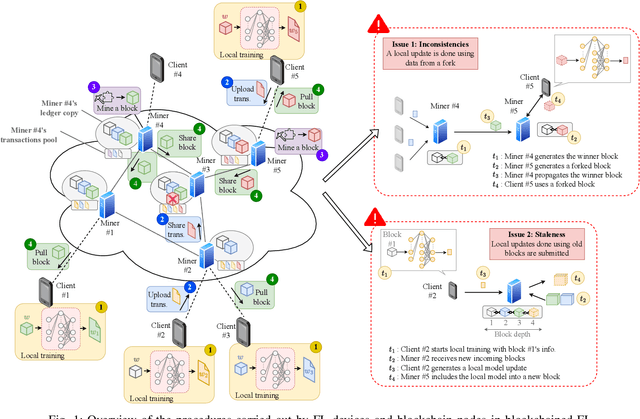
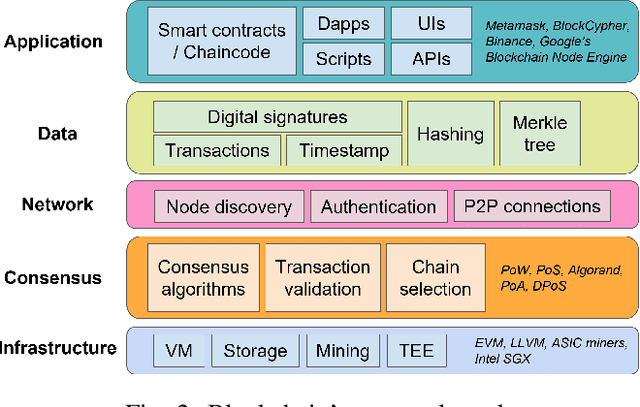
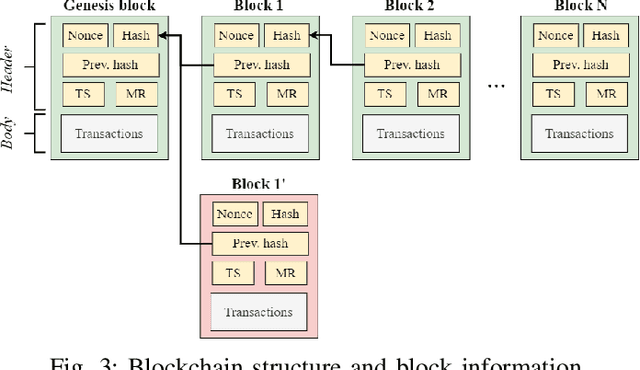
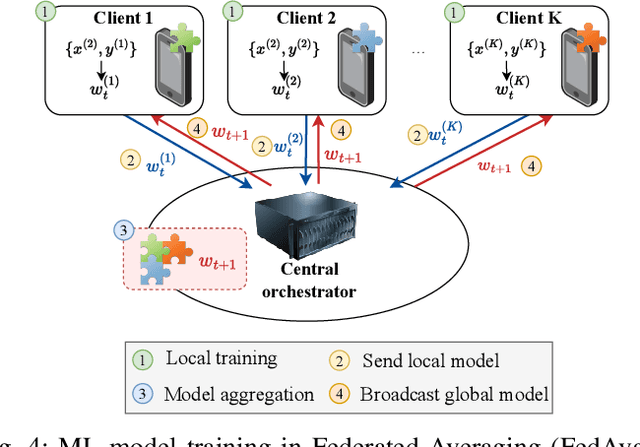
Abstract:Blockchain promises to enhance distributed machine learning (ML) approaches such as federated learning (FL) by providing further decentralization, security, immutability, and trust, which are key properties for enabling collaborative intelligence in next-generation applications. Nonetheless, the intrinsic decentralized operation of peer-to-peer (P2P) blockchain nodes leads to an uncharted setting for FL, whereby the concepts of FL round and global model become meaningless, as devices' synchronization is lost without the figure of a central orchestrating server. In this paper, we study the practical implications of outsourcing the orchestration of FL to a democratic network such as in a blockchain. In particular, we focus on the effects that model staleness and inconsistencies, endorsed by blockchains' modus operandi, have on the training procedure held by FL devices asynchronously. Using simulation, we evaluate the blockchained FL operation on the well-known CIFAR-10 dataset and focus on the accuracy and timeliness of the solutions. Our results show the high impact of model inconsistencies on the accuracy of the models (up to a ~35% decrease in prediction accuracy), which underscores the importance of properly designing blockchain systems based on the characteristics of the underlying FL application.
AI/ML-based Load Prediction in IEEE 802.11 Enterprise Networks
Oct 11, 2023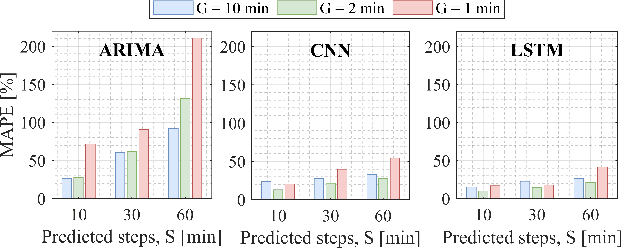
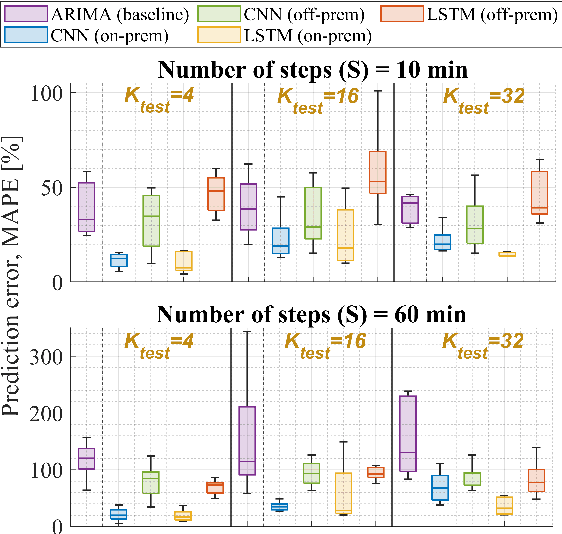
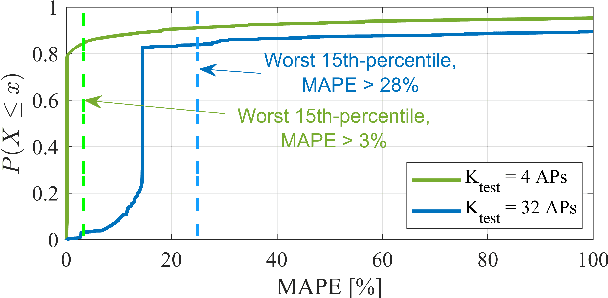
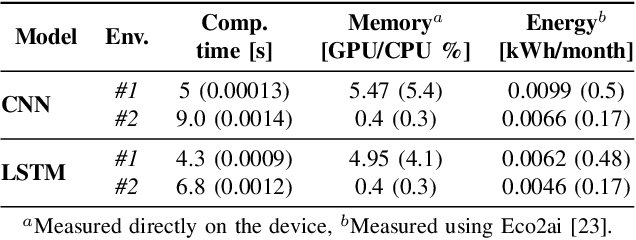
Abstract:Enterprise Wi-Fi networks can greatly benefit from Artificial Intelligence and Machine Learning (AI/ML) thanks to their well-developed management and operation capabilities. At the same time, AI/ML-based traffic/load prediction is one of the most appealing data-driven solutions to improve the Wi-Fi experience, either through the enablement of autonomous operation or by boosting troubleshooting with forecasted network utilization. In this paper, we study the suitability and feasibility of adopting AI/ML-based load prediction in practical enterprise Wi-Fi networks. While leveraging AI/ML solutions can potentially contribute to optimizing Wi-Fi networks in terms of energy efficiency, performance, and reliability, their effective adoption is constrained to aspects like data availability and quality, computational capabilities, and energy consumption. Our results show that hardware-constrained AI/ML models can potentially predict network load with less than 20% average error and 3% 85th-percentile error, which constitutes a suitable input for proactively driving Wi-Fi network optimization.
Towards Energy-Aware Federated Traffic Prediction for Cellular Networks
Sep 19, 2023Abstract:Cellular traffic prediction is a crucial activity for optimizing networks in fifth-generation (5G) networks and beyond, as accurate forecasting is essential for intelligent network design, resource allocation and anomaly mitigation. Although machine learning (ML) is a promising approach to effectively predict network traffic, the centralization of massive data in a single data center raises issues regarding confidentiality, privacy and data transfer demands. To address these challenges, federated learning (FL) emerges as an appealing ML training framework which offers high accurate predictions through parallel distributed computations. However, the environmental impact of these methods is often overlooked, which calls into question their sustainability. In this paper, we address the trade-off between accuracy and energy consumption in FL by proposing a novel sustainability indicator that allows assessing the feasibility of ML models. Then, we comprehensively evaluate state-of-the-art deep learning (DL) architectures in a federated scenario using real-world measurements from base station (BS) sites in the area of Barcelona, Spain. Our findings indicate that larger ML models achieve marginally improved performance but have a significant environmental impact in terms of carbon footprint, which make them impractical for real-world applications.
Throughput Analysis of IEEE 802.11bn Coordinated Spatial Reuse
Sep 17, 2023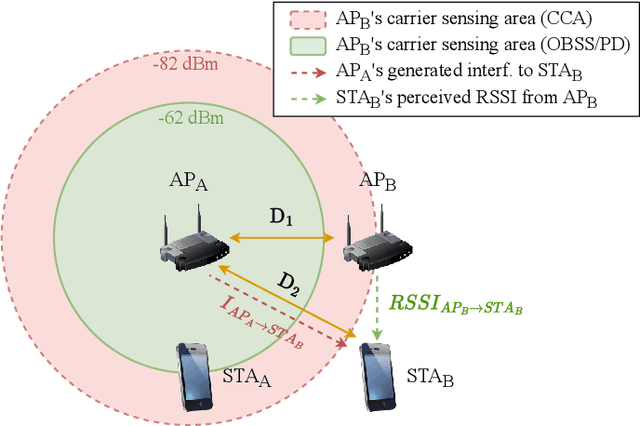
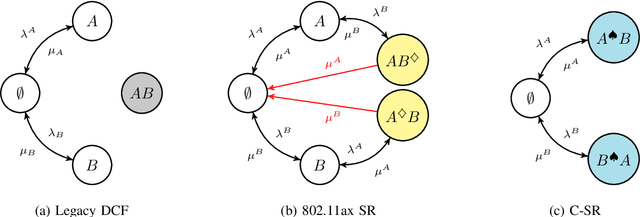
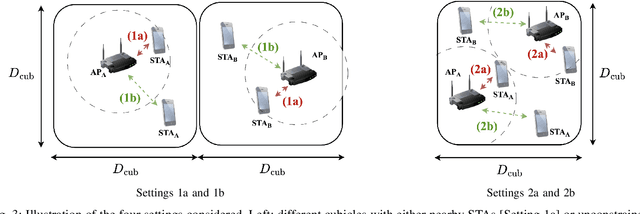

Abstract:Multi-Access Point Coordination (MAPC) is becoming the cornerstone of the IEEE 802.11bn amendment, alias Wi-Fi 8. Among the MAPC features, Coordinated Spatial Reuse (C-SR) stands as one of the most appealing due to its capability to orchestrate simultaneous access point transmissions at a low implementation complexity. In this paper, we contribute to the understanding of C-SR by introducing an analytical model based on Continuous Time Markov Chains (CTMCs) to characterize its throughput and spatial efficiency. Applying the proposed model to several network topologies, we show that C-SR opportunistically enables parallel high-quality transmissions and yields an average throughput gain of up to 59% in comparison to the legacy 802.11 Distributed Coordination Function (DCF) and up to 42% when compared to the 802.11ax Overlapping Basic Service Set Packet Detect (OBSS/PD) mechanism.
 Add to Chrome
Add to Chrome Add to Firefox
Add to Firefox Add to Edge
Add to Edge